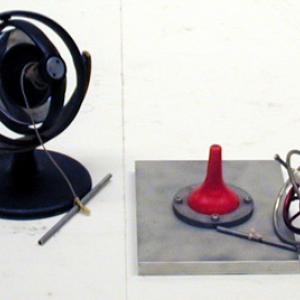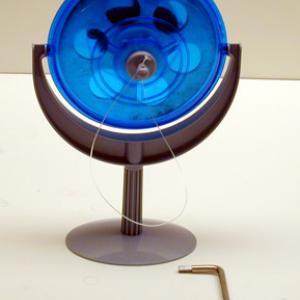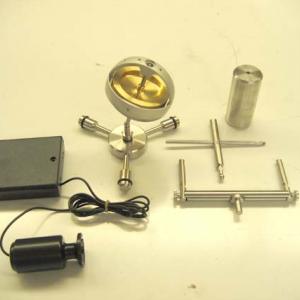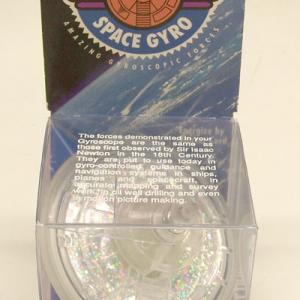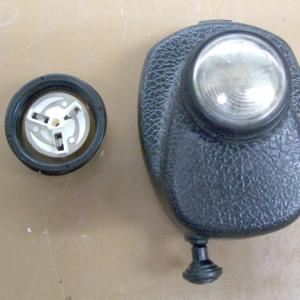College of Liberal Arts & Sciences
1Q50.70 - Gyroscopes
The black Gyroscope is the best one for use when showing that the Gyroscope tries to stay in the same plane.
The red Gyroscope can be hand started by rolling along a bench or pulling with a string. When pulling with a string care must be used so that you do not pull the Gyroscope out of the gimbal.
The crank may be used to wind up the blue Gyroscope. This Gyroscope is not very well balanced so it will probably need to be fixed to the lecture bench.
While a little small, the gyroscope with the motor starter can be quite good for gyroscopic studies.
The gyroscopic shaver was developed for use on the space shuttle/space station where electricity is at a premium.
- J. Ronald Galli and Bradley W. Carroll, "The Four-Ball Gyro and Motorcycle Countersteering", TPT, Vol. 55, #4, Apr. 2017, p. 238.
- Svilen Kostov and Daniel Hammer, "‘It Has to Go Down a Little, in Order to Go Around’ — Revisiting Feynman on the Gyroscope", TPT, Vol. 49, #4, Apr. 2011, p. 216.
- Peter L. Tea, Jr., "Essay on Gyroscopic Motions", TPT, Vol. 26, #1, Jan 1988, p. 22.
- J. Higbie, "Precession of a Gyroscope", TPT, Vol. 18, #3, Mar. 1980, p. 210.
- J. Higbie, "The Physics of the 'Dyna Bee'", TPT, Vol. 18, #2, Feb. 1980, p. 147.
- J. T. Lloyd, "Lord Kelvin Demonstrated", TPT, Vol. 18, #1, Jan. 1980, p. 16.
- Roy Coleman, "Air Bearing Gyroscope", TPT, Vol. 11, #6, Sept. 1973, p. 361.
- Steven C. Sahyun and Philip J. Siemens, "CageLab: A Low-Cost Apparatus to Demonstrate Rotational Motion for Advanced Undergraduates", AJP, Vol. 73, #6, June 2005, p. 566.
- P. G. Heyda, "Roller Ball Dynamics Revisited", AJP, Vol. 70, #10, Oct. 2002, p. 1049.
- William B. Case and Michael A. Shay, "On the Interesting Behavior of a Gimbal-Mounted Gyroscope", AJP, Vol. 60, #6, June 1992, p. 503.
- Harold A. Daw, "A Large Demonstration Gyroscope", AJP, Vol. 56, #7, July 1988, p. 657.
- P. L. Edwards, "A Physical Explanation of the Gyroscope Effect", AJP, Vol. 45, #12, Dec. 1977, p. 1194.
- William Case, "The Gyroscope: An Elementary Discussion of a Child's Toy", AJP, Vol. 45, #11, Nov. 1977, p. 1107.
- Guenter Schwarz and T. Walley Williams III, "Seat for an Air Supported Gyroscope", AJP, Vol. 35, #10, Oct. 1967, p. xii.
- H. L. Armstrong, "On the Precession and Nutation of Gyroscopes", AJP, Vol. 35, #9, Sept. 1967, p. 883.
- Harold A. Daw, "Two Air-Supported Devices for Physics Laboratories and for Physics Demonstrations", AJP, Vol. 33, #4, Apr. 1965, p. 322.
- "M-710, MITAC Gyro & Toy Top", DICK and RAE Physics Demo Notebook, 1993.
- G. D. Freier and F. J. Anderson, "Mu-8", A Demonstration Handbook for Physics.
- G. D. Freier and F. J. Anderson, "Mu-6", A Demonstration Handbook for Physics.
- G. D. Freier and F. J. Anderson, "Mu-5", A Demonstration Handbook for Physics.
- Wallace A. Hilton, "M-19a", Physics Demonstration Experiments.
- George M. Hopkins, "Electrical Gyroscope for Showing the Rotation of the Earth", Experimental Science, p. 28.
- George M. Hopkins, "The Gyroscope", Experimental Science, p. 19.
- Jodi and Roy McCullough, "Center of Gravity with a Top", The Role of Toys in Teaching Physics, p. 4.120.
- Jodi and Roy McCullough, "Gyroscopic Motion with a Gravitron", The Role of Toys in Teaching Physics", p. 4.96.
- Jearl Walker, "1.105. A Headstrong Suitcase", The Flying Circus of Physics Ed. 2, p. 53.
- Ed Sobey and Woody Sobey, "Gyroscope", The Way Toys Work, p. 60.
- James Cunningham and Norman Herr, "5.3.5. Conservation of Angular Momentum", Hand - On Physics Activities with Real Life Applications.
- Peter J. Brancazio, "How Do You Balance a Bicycle?", Mechanics of Solids, p. 51.
- Ron Hipschman, "Gyroscope", Exploratorium Cookbook III, p. 138-1 - 138-3.
- Ron Hipschman, "Bicycle Wheel Gyro", Exploratorium Cookbook II, p. 84-1 - 84-4.
- Joey Green, "Spinning", The Mad Scientist Handbook, Vol. 2, p. 97.
Disclaimer: These demonstrations are provided only for illustrative use by persons affiliated with The University of Iowa and only under the direction of a trained instructor or physicist. The University of Iowa is not responsible for demonstrations performed by those using their own equipment or who choose to use this reference material for their own purpose. The demonstrations included here are within the public domain and can be found in materials contained in libraries, bookstores, and through electronic sources. Performing all or any portion of any of these demonstrations, with or without revisions not depicted here entails inherent risks. These risks include, without limitation, bodily injury (and possibly death), including risks to health that may be temporary or permanent and that may exacerbate a pre-existing medical condition; and property loss or damage. Anyone performing any part of these demonstrations, even with revisions, knowingly and voluntarily assumes all risks associated with them.
